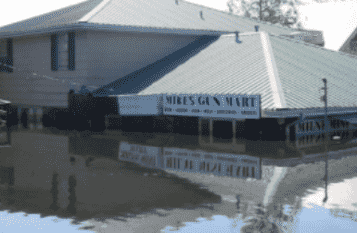The Bureau of Alcohol, Tobacco, Firearms, and Explosives released a pamphlet titled, “Disaster Preparedness for Federal Firearms Licensees” last week.
The objective of the instruction is to help ensure that gun dealers are ready for a Sh*t Hit The Fan (SHTF) scenario.
The ATF “recommends that all FFLs prepare a Disaster Preparedness Plan,” states the agency.
“FFLs have a two-fold interest in having a plan in place: the need to safeguard their business to facilitate a quick recovery and the need to protect the public from the risk of theft/loss of firearms and ammunition,” it continues.
While the ATF guidance is geared toward FFLs, it certainly extends to all gun owners as well. Everyone ought to have a plan in place if there’s a disaster, e.g. flood, hurricane, tornado, wildfire, earthquake, ice storm, power outage, computer system failure, explosion, chemical spill, civil disturbance, structural fire or criminal encounter.
Here is the Five-Part Checklist from the ATF:
RECORDS: Create and maintain a current set of records that includes insurance policies, suppliers and contact lists, and computer records backup. Store these in fire and waterproof locations. Keep current copies of important records off-site. If a disaster is imminent, contact ATF to seek approval to remove all business records to a safe location.
EMPLOYEES: Maintain a list of all employees’ phone numbers, and if warranted, create a phone tree for notifications. Establish a plan under which, in the event of disaster, employees know whom to call to report that they are safe.
INVENTORY: Conduct an inventory and ensure that records are up to date. These will be vital to assisting law enforcement and establishing losses for insurance purposes. Secure your inventory by utilizing safes, cable locks and other measures that can deter burglaries and looting. If a disaster is imminent, consider relocating inventory. FFLs are encouraged to inform ATF of the new firearms inventory location.
INSURANCE: Review your policy annually. Most policies do not cover floods and other natural disasters. Consider enhancements to your policy for more complete coverage and reimbursement for business disruption in addition to physical losses.
SECURITY: Review your alarm system and consider updating antiquated systems like VCR cameras. Consider having more than one security service evaluate your current system.
***
All pretty sound advice, especially for FFLs. Beyond that, you should check out our Prepping 101 series if you haven’t already because while it’s important to ensure that your firearms are secure, what’s even more critical is that you survive come what may. What good is a safe filled with dry guns if you don’t have food to eat or potable water to drink?
You need to start planning now! It’s not a matter of if a disaster will come your way, it’s only a matter of when. As Paul, our prepping expert, likes to say, 10 years too early is better than 2 seconds too late.


Though it’s common-sense stuff (for real, this time) from BATFE, we still need to be vigilant for when they forget they’re charged with defending and enforcing the Constitution, including the Second Amendment. It’s not a bit personal.
Actually I kinda hope my local FFL does not use waterproof and fireproof storage methods.
I keep reading this headline “ATF Releases Pamphlet on Disaster Preparedness for FFLs” last week. The pamphlet is from December 2009. The ATF did not release it last week. They’re reminding FFLs like me about it because there are morons out there still that think, “It can’t happen to me.”
funny i thought there would be something in here about rounding up FFL’s firearms or private owners guns as they done during Katrina. lucky for me where i live our state government passed a law that tells the cops flat out that they in no way can go around and take peoples guns away from them no matter what is going on.
The second amendment recognized that very same right. You see how that went.